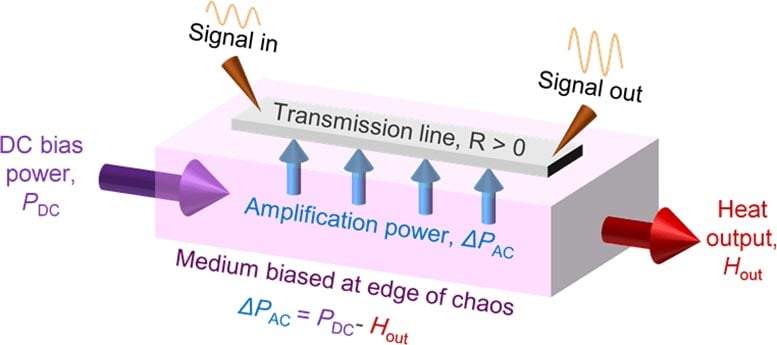

Researchers have discovered how the “edge of chaos” can help electronic chips overcome signal losses, making chips simpler and more efficient.
By using a metallic wire on a semi-stable material, this method allows for long metal lines to act like superconductors and amplify signals, potentially transforming chip design by eliminating the need for transistor amplifiers and reducing power usage.
Revolutionizing Chip Design With the Edge of Chaos
A stubbed toe immediately sends pain signals to the brain through several meters of axons, which are composed of highly resistive fleshy material. These axons operate using a principle known as the “edge of chaos,” or semi-stability, enabling the swift and precise transmission of information.
This research demonstrates the edge of chaos in action within an artificial system by conducting electricity through an inorganic material. Typically, the edge of chaos amplifies noise. However, in a surprising twist, a metallic wire placed atop a material at the edge of chaos not only conducted but also amplified useful signals. This method effectively counters the resistive loss in metal that typically degrades signal integrity.
Modern electronic chips comprise numerous components and extensive metal wiring, known as interconnects. These contribute to significant resistive signal losses, which are a major drain on chip power. The conventional solution has been to segment these wires into shorter lengths and incorporate transistors to boost and relay the diminished signals.
This innovative new approach eliminates the need for transistor amplifiers and enables a long metal line to achieve not only superconductor-like zero electrical resistance but also enhance small signals. Such advancements could radically simplify chip design and greatly enhance efficiency.

Advancing Signal Transmission in Electronics
Electrical signals traveling through metallic conductors lose strength due to the inherent resistance of the metal. To compensate, traditional methods require repeatedly disrupting the conductor to insert amplifiers that regenerate the signal. This technique, which has been used for more than a century, limits the design and performance of modern, densely interconnected chips. In contrast, this work introduces a new approach based on harnessing the semi-stable edge of chaos (EOC), a regime that scientists theorized but have not previously demonstrated. This regime supports active signal transmission similar to the self-amplification seen in biological axons.
Harnessing the Semi-Stable Edge of Chaos for Efficient Electronics
By electrically accessing the spin crossover in lanthanum cobaltite (LaCoO3), the researchers isolated the semi-stable EOC and invoked negative resistance and signal amplification in a metallic transmission line without the need for separate amplifiers, and at normal temperatures and pressures. Operando thermal mapping revealed that the energy used to maintain the EOC is not fully lost as heat, but is partly redirected to amplify the signal, thereby enabling continuous active transmission and potentially revolutionizing chip design and performance.
Reference: “Axon-like active signal transmission” by Timothy D. Brown, Alan Zhang, Frederick U. Nitta, Elliot D. Grant, Jenny L. Chong, Jacklyn Zhu, Sritharini Radhakrishnan, Mahnaz Islam, Elliot J. Fuller, A. Alec Talin, Patrick J. Shamberger, Eric Pop, R. Stanley Williams and Suhas Kumar, 11 September 2024, Nature.
DOI: 10.1038/s41586-024-07921-z
This work was primarily supported as part of the Center for Reconfigurable Electronic Materials Inspired by Nonlinear Neuron Dynamics (reMIND), an Energy Frontier Research Center (EFRC) funded by the Department of Energy Office of Science, Basic Energy Sciences. The Laboratory Directed Research and Development (LDRD) program at Sandia National Laboratories provided internal support to the reMIND EFRC. All authors of this work were supported directly by reMIND or by the LDRD program.